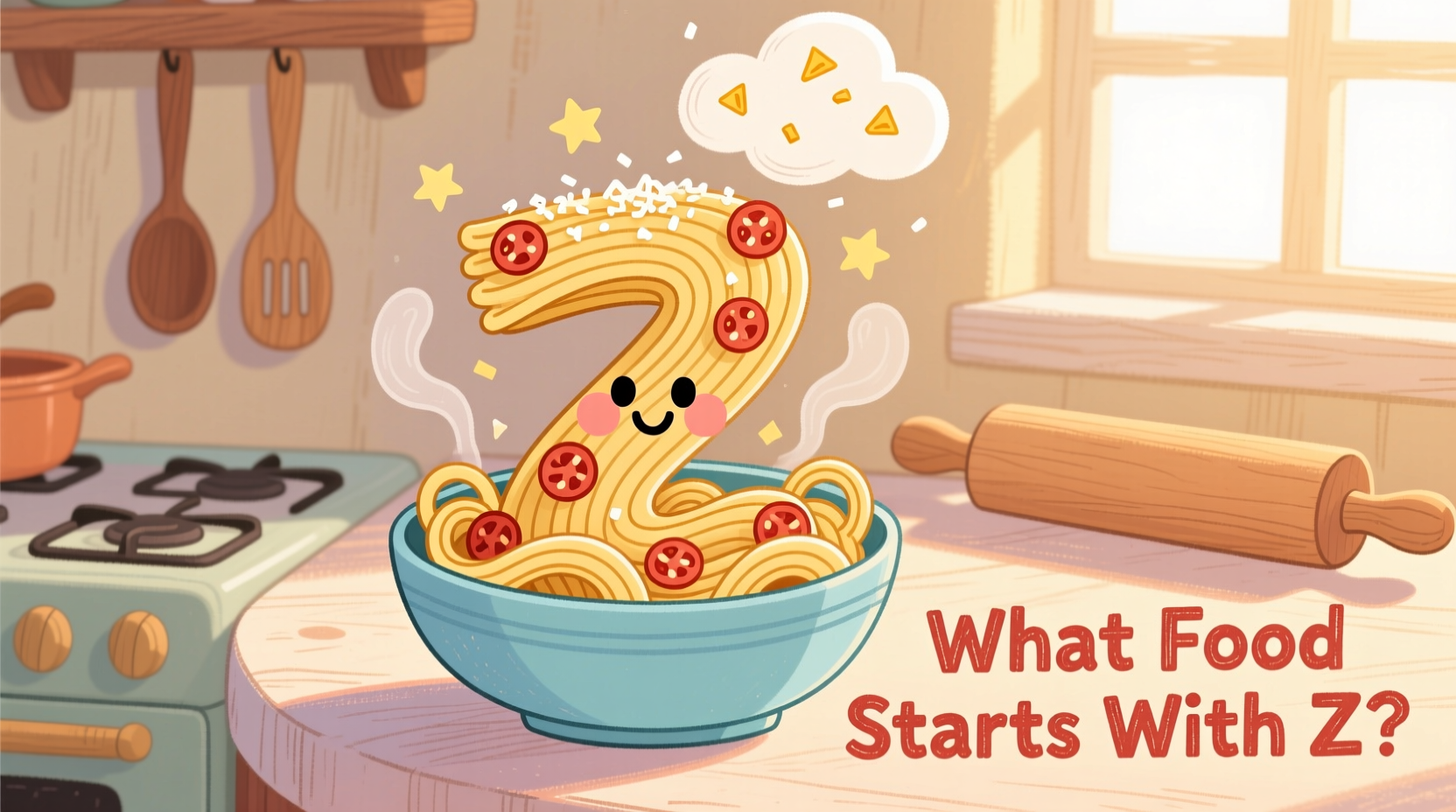Why Z Foods Are So Rare in English
The letter Z is the least frequently used in the English language, making Z-starting food names exceptionally uncommon. While many languages have more Z foods, English culinary vocabulary adopted very few. This linguistic rarity creates challenges for alphabet games and educational activities, but understanding the cultural origins of these limited options provides valuable context.
Authentic Foods Beginning with Z
Zucchini: The Most Common Z Food
Zucchini (also called courgette in British English) is a summer squash that originated in Mesoamerica but was developed into its current form in Italy. This versatile vegetable appears in Mediterranean cuisines worldwide and has become a kitchen staple for good reason.
According to the USDA FoodData Central, one cup of raw zucchini (124g) provides:
| Nutrient | Amount | % Daily Value |
|---|---|---|
| Calories | 20 | 1% |
| Fiber | 1.2g | 4% |
| Vitamin C | 21mg | 23% |
| Vitamin A | 300IU | 10% |
| Potassium | 298mg | 8% |
Professional chefs prize zucchini for its mild flavor and ability to absorb other ingredients' flavors while maintaining texture. When selecting zucchini, choose firm specimens with smooth, unblemished skin about 6-8 inches long for optimal flavor and texture.

Ziti: Classic Italian Pasta Shape
Ziti refers to a tube-shaped pasta originating from Southern Italy, particularly Campania. The name comes from the Sicilian word "zita," meaning bride, as this pasta traditionally featured at wedding feasts.
Food historians note that ziti's history dates back to at least the 14th century, with references appearing in Encyclopedia Britannica's pasta history timeline. Unlike some modern pasta shapes designed for specific sauces, ziti works well with both chunky tomato sauces and baked preparations like pasta al forno.
Za'atar: Middle Eastern Spice Blend
Za'atar isn't a single food but a traditional spice blend with ancient roots across the Levant. The classic mixture typically includes:
- Dried thyme
- Oregano or marjoram
- Sesame seeds
- Sumac (for tanginess)
This versatile blend serves multiple culinary purposes - as a dip with olive oil, seasoning for meats, or sprinkled on flatbreads. The National Center for Biotechnology Information documents za'atar's historical use in traditional medicine across Middle Eastern cultures.
Zante Currants: Tiny Dried Grapes
Despite their name, Zante currants aren't actually currants but small dried grapes from the Black Corinth variety. They originate from the Greek island of Zakynthos (Zante in Italian), hence the name.
Unlike larger raisins or commercial currants, Zante currants have a distinctive tart-sweet flavor profile. The Food and Agriculture Organization notes these miniature dried fruits have been traded throughout the Mediterranean since ancient times, featuring in both sweet and savory applications.
Less Common Z Foods Worth Knowing
Zapote: Tropical Fruit Varieties
Zapote (sometimes spelled sapote) refers to several tropical fruits, most notably:
- Black sapote - Often called "chocolate pudding fruit" for its texture and color
- Mamey sapote - Features salmon-colored flesh with a sweet, almond-like flavor
- White sapote - Mildly sweet with a citrus undertone
These fruits remain relatively obscure outside their native Central American regions but are gaining popularity among specialty food enthusiasts. The University of Florida's Institute of Food and Agricultural Sciences documents their increasing cultivation in suitable climates.
Zongzi: Traditional Chinese Rice Dumplings
Zongzi are glutinous rice dumplings wrapped in bamboo leaves, traditionally eaten during the Dragon Boat Festival. While "zongzi" begins with Z in English transliteration, the Chinese characters don't correspond to the letter Z.
These pyramid-shaped treats can contain sweet or savory fillings, varying by region across China and Southeast Asia. Food anthropologists consider zongzi one of the earliest forms of portable meals in Chinese culinary history.
Common Misconceptions About Z Foods
Many purported "Z foods" don't qualify as actual food items:
- Zest - Refers to citrus peel, not a standalone food
- Zoodles - A portmanteau of "zucchini noodles," not a distinct food
- Ziti pasta - Redundant since ziti is already pasta
- Ziti noodles - Incorrect terminology (ziti is the shape)
Understanding these distinctions helps avoid common errors when compiling alphabetically organized food lists or playing word games requiring authentic food names.
Practical Applications for Z Foods
Culinary Uses for Zucchini
Move beyond basic sautéing with these professional techniques:
- Salt and rest sliced zucchini for 20 minutes before cooking to remove excess moisture
- Create zucchini ribbons with a vegetable peeler for elegant salads
- Make zucchini carpaccio by thinly slicing and marinating in lemon-herb dressing
- Use large zucchini as edible boats for stuffed preparations
Incorporating Za'atar Into Your Cooking
This versatile spice blend enhances numerous dishes:
- Mix with olive oil as a bread dip alternative to traditional Italian seasonings
- Rub on chicken or fish before roasting for Mediterranean flavor
- Sprinkle over hummus or labneh for added complexity
- Add to flatbread dough for savory homemade pita
Why This Matters for Word Games and Educational Activities
When playing alphabet-based games like Scrabble, Boggle, or educational food-themed activities, knowing authentic Z foods prevents common mistakes. Teachers creating alphabet food charts should verify entries to maintain accuracy, as many online sources incorrectly list non-food items or redundant terms as Z foods.
For trivia enthusiasts, understanding that zucchini, ziti, za'atar, and zante currants represent the primary authentic options provides valuable knowledge that separates casual players from serious competitors in word games requiring food knowledge.
Conclusion: Making the Most of Limited Z Options
While the scarcity of Z foods presents challenges for alphabet activities, it also creates opportunities to explore culinary diversity. By understanding the cultural contexts and proper uses of these limited options, you can confidently navigate word games, educational projects, and even expand your cooking repertoire with these unique ingredients.











 浙公网安备
33010002000092号
浙公网安备
33010002000092号 浙B2-20120091-4
浙B2-20120091-4